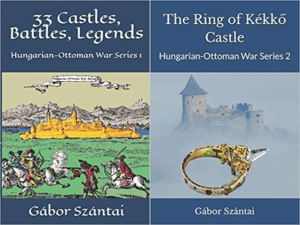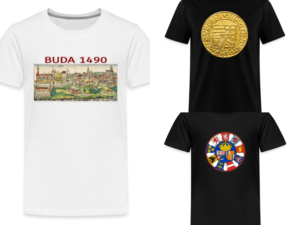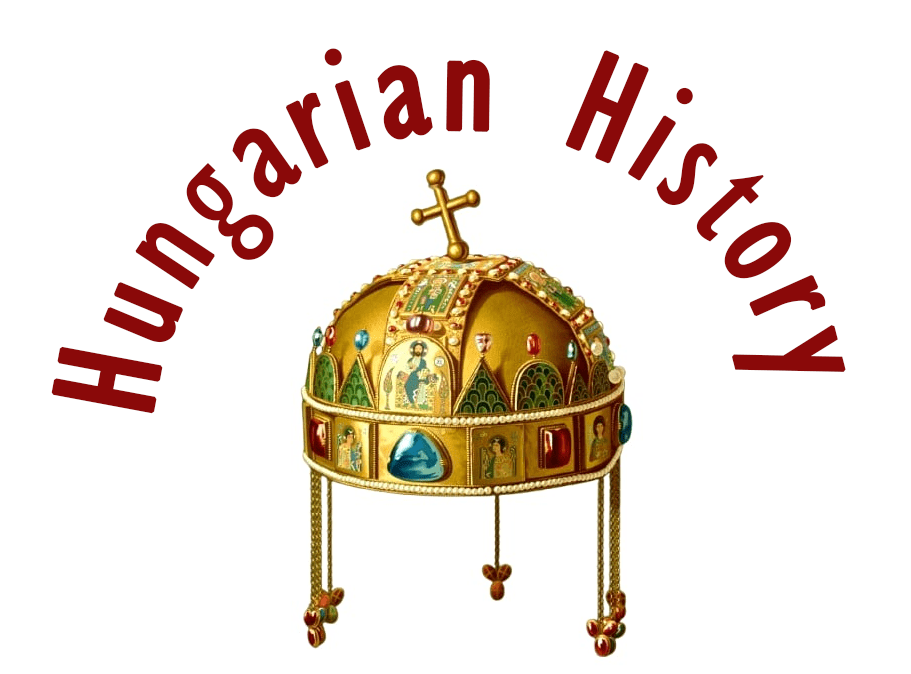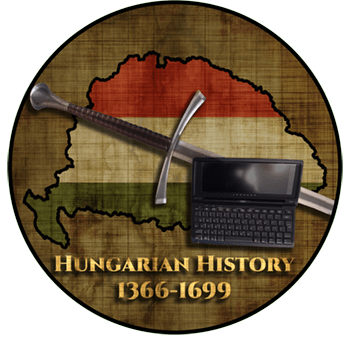
It was believed for a long time that the holy king would emerge from his tomb when the Hungarians were in great danger and help his people to victory. In the summer of 1354, when the Székelys were fighting their death battle with the Mongols (Tatars), old Tatars told of a ‘great knight who came before them, riding on a high steed, with a golden crown on his head and a battle-axe in his hand, and who destroyed them all with great blows and cuts’, according to the anonymous Minorite’s chronicle.

According to legend, he decided the battle in favour of the Hungarians, and after the battle, King László’s embalmed body was covered in sweat and was found at Várad. You can read more about the history of the famous bronze statue of King Saint László that was erected in front of the cathedral of Nagyvárad (Várad / Oradea), which was the first great mounted statue after late antiquity:

Saint Ladislaus
Louis the Great gave his command:
“Ride out, Laczfi — sword in hand!
Lose no time; be swift, be brave,
Buckle your saber, strike, and save.
The Tatar threat draws ever near,
They press our borders — Moldva’s sphere.
Take the Székelys, fierce and proud,
Ten thousand nobles, war-allowed!”
Thus, brave Laczfi rode from Buda,
Bound for mighty Várad.
Through the millet fields of Kunság,
Marched his cohorts, strong and steadfast.
On Várad’s gravel streets they came,
Steel-shod hooves struck out like flame.
Weapons flashed beneath the sun,
Their thundered march could not be outrun.
Saint Ladislaus, within the shrine,
Hears the hoofbeats through the pine.
By Körös’ banks the temple stands —
And life stirs back through lifeless hands.
A spark returns behind his eyes,
He draws a breath, begins to rise.
The stone lid seals him, old and grim,
Three hundred years have pressed on him.
“At last,” he says, “some air, some space —
This narrow house, a stifling place.”
He straps his sword upon his side,
And takes his battle-axe with pride —
The same that once in Eastern lands
Struck down the pagan, cursed bands.
He sets his crown upon his brow,
Long askew — it sits straight now.
Perhaps it’s midnight, cold and deep,
As iron doors swing wide from sleep.
Out he steps into the square,
Turns to the right — the statue’s there.
High it stands in shadowed might,
A mounted king in metal light.
The steed below begins to shake,
It knows his touch — its senses wake.
It rears and screams, all iron flame,
And throws the rider from the frame.
Its bridle foams with battle fire,
It paws, it whinnies, and breathes desire.
Ladislaus shakes the saddle tight,
Spurs his steed to fearless flight.
From lofty stone they leap as one,
O’er hills and vales, their journey runs.
The horse and rider, long since gone,
Ride onward through the breaking dawn.
Just one leap to Calvary’s rise,
And nine more to King’s Pass lies.
They hear the clatter of swift hooves —
The wild Székelys and Csángó moves.
Yet horse and rider, none can see,
By mortal eyes — a mystery.
Amazing, yes! But miracles
Are wrought by God’s own will and skill.
For three long days did Laczfi fight,
The pagan foe in deadly plight.
The Székely heart was strong and true,
But Székely fighters—far too few.
While Tatars, like the drifting chaff,
Or dust upon the endless grass,
Screamed out and shot their arrows wide,
And darkened all the sunlight’s pride.
Now, Székelys barely hold their ground,
The great flag’s threat is all around.
Then bursts a roar, fierce and loud:
“O God, my Lord! Saint Ladislaus!”
Like lions fierce, the Székelys strike,
Though pressed, they will not yield nor break…
Upon the ridge, though out of sight,
Clatters the metal steed’s might.
“Here, here, good warriors!” he cries,
Endre Laczfi calls his allies.
Then a sudden rush, wild and fierce,
The pagan lines begin to pierce.
The clash grows loud, the earth might shake,
Many freeze still, like frozen shapes.
Fear steals their minds, their reason slips,
Frozen there, in terror’s grip.
The battle axe flies through the fray,
Strikes many down who run away.
Some won’t flee, they stand too late—
Their horse is loot, their chains are fate.
Even their chieftain, Atlamos,
Fell to shame and fatal loss.
His blood pours from a mortal blow—
No healer’s art can stop its flow.
Back to Buda rides Laczfi bold,
With prisoners marching, young and old.
So many flags, so rich the prey—
Such spoils are rare on any day.
The Tatar ranks in chains now file,
Still trembling all the weary while.
Their heads are bowed in humbled plight—
They beg for Christ and holy light.
When they reach the gates of Várad,
It’s Saint Ladislaus’s feast day, marked.
The wildmen line up by the score,
For baptism, Laczfi stands as lord.
A sea of people crowds the square,
To witness wonders in the air.
From a grave-bound Tatar, old and grey,
A silver tongue begins to say:
Not Székely steel, nor Laczfi’s hand
— may God yet grant him many a span —
But Ladislaus, that king of light,
struck us down and won the fight.
Summoned once, he took the field,
tower-tall in streaming steel;
before nor since in the ranks of war
Has mortal eye beheld such awe?
A giant rode a giant steed, a
formidable yet kingly-stately breed.
A dusk-hued crown of battered gold,
gem-lit embers round it rolled.
Lightning-quick, his war-axe swung;
No man, no worm would wait so long.
For this was no world-woven man,
No living soul of mortal span.
For this was no man born of earth,
No soul of flesh, no mortal birth.
Above his helm a form did rise—
A maiden shining in the skies.
Her crown was forged of living flame,
Sunlight wrapped around her name.
And all the crowd cried out to see:
“Saint Ladislaus—and Mary!”
And the tale the old Tatar spoke—
Though none had cause to think it a joke—
Was confirmed by a trusted eye,
A temple guard who dared not lie.
He searched the tomb for three whole days—
No saintly body met his gaze.
But on the fourth, there lay the king,
With sweat upon his embalmed skin.”
(Translation: Szántai Gábor)

You can listen to the poem in Hungarian as well, told by Csernák János:
https://www.youtube.com/watch?v=MlyVwrNlr9w
You can also watch a short video with English subtitles about the king’s life:
https://www.youtube.com/watch?v=QlbrqOK3-X0
Here is the original Hungarian poem of Arany János:
SZENT LÁSZLÓ
Legenda (Arany János)
“Monda Lajos a nagy király: Eredj szolgám, Laczfi Endre, Küldj parancsot, mint a villám, Köss nehéz szablyát övedre: A tatártól nagy veszélyben Forog Moldva, ez a véghely: A tatárra veled menjen Tízezernyi lófő székely.
Kél Budáról Laczfi Endre, Veszi útját Nagy-Váradnak; Kölestermő Kunság földén Jó csatlósi áthaladnak; Várad kövecses utcáin Lovuk acél körme csattog, Messzefénylik a sok fegyver, Messzedöng a föld alattok.
Hallja László a templomban Körösvíznek partja mellett; Visszatér szemébe a fény, Kebelébe a lehellet; Koporsója kőfedelét Nyomja szinte három század: Ideje már egy kevéssé Szellőztetni a szűk házat.
Köti kardját tűszöjére S fogja a nagy csatabárdot, Mellyel egykor napkeleten A pogánynak annyit ártott; Félrebillent koronáját Halántékin igazítja; Éjféltájban lehetett már – A vasajtót feltaszítja.
És megindul, ki a térre; És irányát vészi jobbra, Hol magasan felsötétlik Ércbül öntött lovagszobra; Távolról megérzi a mén, Tombol, nyerít, úgy köszönti: Megrázkódik a nagy ércló S érclovagját földre dönti.
Harci vágytól féke habzik, Kapál, nyihog, lángot fúvall; László a nyeregbe zörren S jelt ad éles sarkantyúval; Messze a magas talapról, A kőlábról messze szöktet; Hegyen-völgyön viszi a ló A már rég elköltözöttet.
Egy ugrás a Kalvária És kilenc a Királyhágó; Hallja körme csattogását A vad székely és a csángó: Ám a lovat és lovagját Élő ember nem láthatja, Csodálatos! – de csodákat Szül az Isten akaratja.
Három teljes álló napig Vívott a pogánnyal Laczfi; Nem hiányzott a székely szív, De kevés a székely harcfi Míg a tatár – több mint polyva, Vagy mint a puszták fövénye – Sivalkodik, nyilát szórja, Besötétül a nap fénye.
Már a székely alig győzi, Már veszélyben a nagy zászló, De fölharsog a kiáltás: “Uram Isten és Szent László!” Mint oroszlán, ví a székely, Megszorítva, nem megtörve… Most a bércen láthatatlan Csattog a nagy ércló körme.
“Ide, ide jó vitézek!” Gyüjti népét Laczfi Endre: Hát egyszer csak vad futással Bomlik a pogányság rende; Nagy tolongásnak miatta Szinte már a föld is rendül; Sok megállván mint egy bálvány, Leragad a félelemtül.
Sokat elüt gyors futtában A repülő kurta csákány; Sok ki nem mozdul helyéből Maga rab lesz, lova zsákmány. Foglyul esett a vezér is Atlamos, de gyalázatja (Nehéz sebben vére elfoly) Életét meg nem válthatja.
Fel, Budára, Laczfi Endre Számos hadifoglyot indít; Annyi préda, annyi zászló Ritka helyen esik, mint itt. Rabkötélen a tatárság Félelemtül még mind reszket. És vezeklik és ohajtja Fölvenni a szent keresztet.
Hogy elértek Nagy-Váraddá, Vala épen László napja – Keresztvízre áll a vad faj, Laczfi lévén keresztapja. Összegyűl a tenger néző Hinni a csodába, melyet Egy elaggott, sírba hajlott Ősz tatárnak nyelve hirdet:
“Nem a székely, nem is Laczfi, Kit Isten soká megtartson; Hanem az a: László! László! A győzött le minket harcon: A hívásra ő jelent meg, Vállal magasb mindeneknél Sem azelőtt, sem azóta Nem láttuk azt a seregnél.
Nagy lovon ült a nagy férfi, Arca rettentő, felséges; Korona volt a fejében Sár-aranyból, kővel ékes; Jobb kezében, mint a villám Forgolódott csatabárdja: Nincs halandó, földi gyarló Féreg, aki azt bevárja.
Mert nem volt az földi ember, Egy azokból, kik most élnek: Feje fölött szűz alakja Látszott ékes nőszemélynek; Koronája napsugárból, Oly tündöklő, oly világos! -” Monda a nép: az Szent-László, És a Szűz, a Boldogságos.
S az öreg tatár beszédét, Noha kétség nincs felőle; Bizonyítá a templomnak Egy nem szavajátszó őre: Hogy három nap a sirboltban Lászlót hiába kereste; Negyednapra átizzadva Találtatott boldog teste.”

Dear Readers, I can only make this content available through small donations or by selling my books or T-shirts.
Please, support me with a coffee here: https://www.buymeacoffee.com/duhoxoxa
You can check out my books on Amazon or Draft2Digital. They are available in hardcover, paperback, or ebook:
https://www.amazon.com/dp/198020490X or at https://books2read.com/b/boYd81

My work can also be followed and supported on Patreon: Become a Patron!http://Become a Patron!
Become a Patron! Donations can be sent by PayPal, too: https://tinyurl.com/yknsvbk7


https://hungarianottomanwars.myspreadshop.com/all
Subscribe to my newsletter here: https://tinyurl.com/4jdjbfkn

